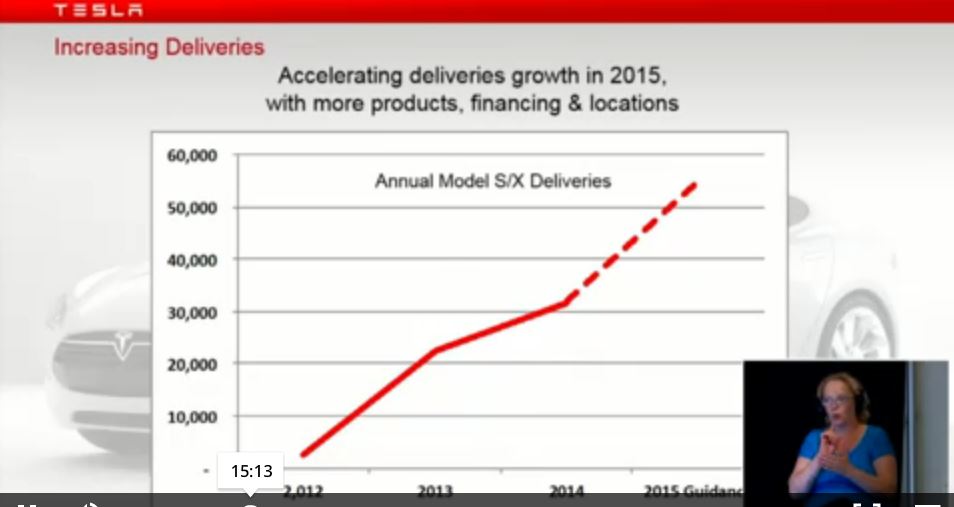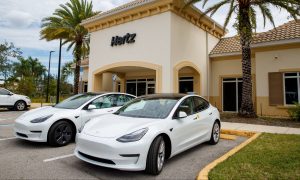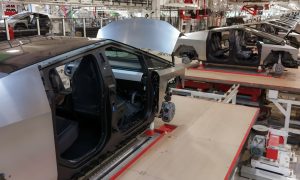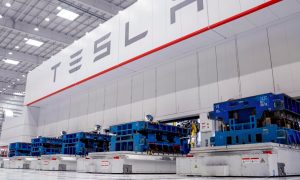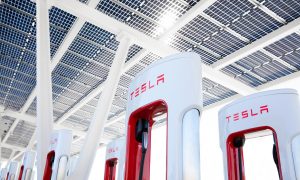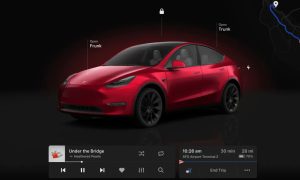During his remarks at the Tesla annual shareholder meeting on Tuesday, chairman Elon Musk touched on a wide range of topics from the AutoPilot system, the GigaFactory, residential and utility scale grid storage, and life on Mars. Here’s a synopsis.
Car Stuff
Musk told the meeting that he anticipates sales volume will continue to grow 50% per year, on average, for the next several years. The company has opened a new casting and machining center near the Fremont factory. Moving production functions there has opened up room at the factory to install a new assembly line capable of producing 3 times as many cars as the current line. A new paint facility capable of handling up to 500,000 cars a year has also been installed.
The Model X is undergoing final pre-production tweaking and will start production in “3 to 4 months.” In response to a question, Musk said that mounting the battery pack low in the chassis makes the Model X one of the safest SUV’s on the road. He went on to say that, like the Model S, it will achieve some of the highest crash test ratings of any car on the road.
“[I]t’s turning out to be a really great car. I think the Model X may arguably be a better SUV than the Model S is as a sedan. We want to make sure obviously that some of the key features of the Model X, particularly the Falcon Wing door and the way the second row seats are done …is…just right, and provide true functionality and true value improvements versus just sort of feeling gimmicky. It’s got to be a genuine improvement in utility and aesthetics, so getting those final nuances right for the Model X is what we’re focused on right now.”
When asked about the affordable mass-market Model 3, he said it would be available only with a single motor at first to keep costs down but would be offered in a dual motor version as well.
He did have exciting news about the Supercharger network. The company is fitting solar panels to as many Supercharger locations as possible. He assured the audience that those that could not be converted to solar power would soon get their electricity only from renewable power sources.
Musk also said the company has created a new liquid cooled charging cord that is significantly thinner and more flexible than the one used now. Not only does liquid cooling make the cable more elegant, it will permit the use of higher powered Supercharger facilities in the future.
He emphasized that the system will continue to expand in North America and other countries to permit Tesla owners to enjoy free long distance driving for life. He did say that owners who use Superchargers for all their daily charging can expect to receive a “note” from the company.
With regard to the AutoPilot suite of autonomous driving features, Musk indicated that the company is busy testing and upgrading the system. “We’re making gradual progress towards what I’d say is a releasable bit of software. But it is quite a tricky thing and we want to make sure that our testing is exhaustive before we release the software. But if we keep making progress, I think we may be able to get it out to all the access customers which is sort of our public beta program around the end of this month.”
Full implementation is not expected for about 3 years, with a lot depending on how regulators in the US and abroad react to it. He said that the system at this point is intended to function like the auto pilot in airplanes — there to help but not to allow drivers to sleep through their journey to arrive alert and refreshed at their destination…..yet.
Musk admitted that interest in battery swapping was far lower than expected. He indicated that the company is focusing more on improving Supercharger performance and less on building battery swap locations.
Tesla PowerWall
One of the biggest announcements of the day concerns the Tesla PowerWall. Some critics have chirped that the units introduced to great fanfare in April were too small to be worth the cost. “I am very happy to announce that we’ve dramatically increased the power capability of the Powerwall. So it’s actually going to go from having 2 kilowatts steady, 3.3 kilowatt peak to a 7 kilowatt power, 5 kilowatt steady, price is unchanged. So, it basically more than doubled the power output of the Powerpack and the price is going to stay the same.”
The company will prioritize deliveries to people who already have a residential solar system or who are installing one. Why? Because an inverter will be already included in their system, meaning adding a PowerWall will cost only about $3,500 for the unit and about $500 for installation. That’s huge.
But even with that announcement, Musk admitted that the PowerWall may not make economic sense for most customers in the US because the differences between the cost of electricity during a 24 hour period are usually not large enough for there to be a pay back on the cost of the system in a reasonable period of time. He cites Germany, Australia and Hawaii as markets where the PowerWall makes more economic sense.
The company focus is on grid scale storage, which it expects will account for 80% of its stationary battery business. “That’s where the economics are very compelling because there is an important difference between price and cost. The cost to the utilities of between day and night is quite substantial because the power usage is often sort of 2:1 at least if not greater than 2:1, sometimes substantially greater than 2:1 between peak day usage and trough night usage.”
Musk told the audience that utility companies look favorably on using Tesla battery storage units because they are more compact than what competitors offer, so they can fit into the footprint of existing substations without the need to acquire more land and the permitting issues that may create. He says utilities are just like residential customers — they appreciate that the Tesla units are basically “plug and play” ready, with no hassles or headaches.
The GigaFactory
Musk said the GigaFactory was coming along smoothly, with production expected to begin next year with full capacity expected within 3 years. In response to a question from the audience, he responded, “Our focus right now is just making sure that we build the Gigafactory version one correctly and that’s going to be quite a difficult challenge over the next few years. We’ll have the first part of it active next year but then we want to try to get to full production in roughly three years…that’s going to be quite a challenge. And I think once we get to that point we want to figure out where to put Gigafactory Two and Three.”
He says the GigaFactory will have the capacity to build 50 gigawatt-hours of batteries a year. “And that should allow for 500,000 cars to be produced a year plus have 15 gigawatt-hours left over for stationary. The way it’s looking, demand for stationary is higher than expected, so we’re looking at potentially expanding the output capability of the Gigafactory to meet the higher demand for stationary.”
SpaceX
An audience member asked when SpaceX would be going public and Musk responded that a SpaceX IPO was a long way off, primarily because the stock market is focused on quarterly reports and has an attention span limited to 1 to 2 years maximum. He said the timeline for SpaceX was quite a bit beyond that. Then he dropped this bomb:
“I’m trying to build a city on Mars and that ends up sacrificing profitability for a really long time. I think it would be not super loved by the public markets. I’d expect with SpaceX that we will probably go public once we will have a regular flights to Mars.”
The Take Away
One stockholder asked Elon Musk what his goals for the company are. He gave this answer, which may serve as the overarching statement that underlies everything he and his various companies are attempting to accomplish.
“Our goal at Tesla is pretty straight forward; it’s really to accelerate the advent of sustainable energy and particularly sustainable transport. So in order for humanity to have a good future or for life…we have to figure out how to make that future sustainable, meaning not to have crazy amounts of CO2 in the atmosphere and ultimately get into situation of hydrocarbon scarcity, which would be economically disastrous.
“So, that’s what we’re focused on. Our primary goal is to accelerate the advent of sustainable transport and then, with the batteries, help the advent of sustainable energy production.”
Quoted material is courtesy of Seeking Alpha transcription service.

